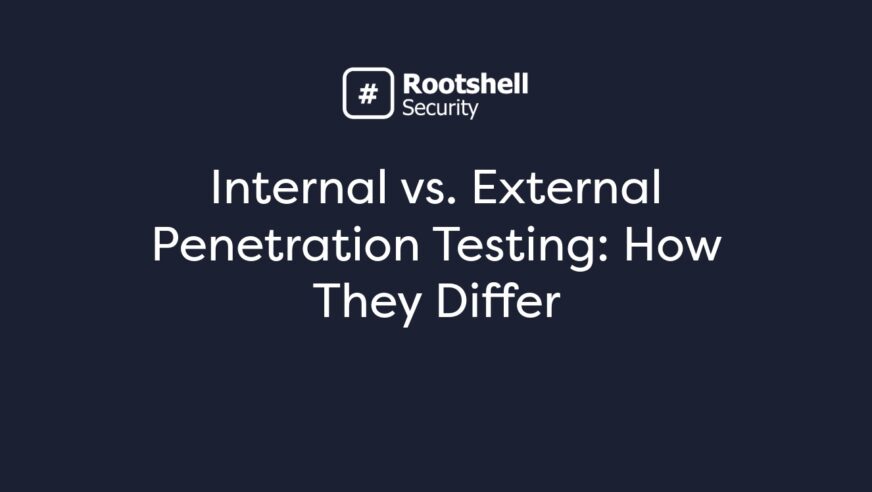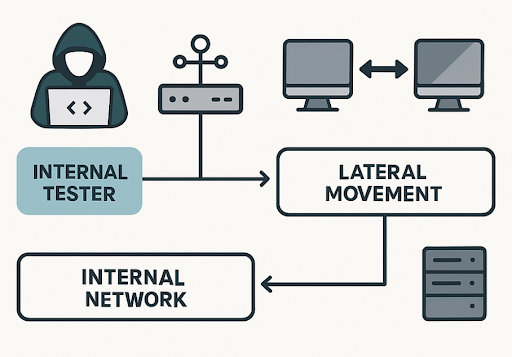Penetration testing, often referred to as ethical hacking, is a structured assessment that recreates real-world cyberattacks to uncover vulnerabilities in IT systems, ideally before they’re discovered by malicious actors.
There are two main approaches: external and internal. External penetration testing focuses on internet-facing assets such as websites, email servers, and firewalls, representing threats from outside the organisation. Internal penetration testing explores what could happen if an attacker gains access to the internal network, whether through a compromised device or insider activity.
This article looks at how internal and external penetration testing differ, the methods used in each, and how both contribute to strengthening your organisation’s security approach.
What Is Penetration Testing?
Penetration testing is a controlled security assessment carried out by professionals who simulate cyberattacks. The goal is to identify weaknesses that could allow unauthorised access, data breaches, or system compromise. With around 600 million cyberattacks detected daily, according to Microsoft, organisations must remain cautious against threats.
Unlike automated vulnerability scans, penetration testing involves manual techniques to exploit flaws, just as a real attacker might. These tests often go deeper than surface-level scans, helping organisations understand how threats could move through networks or exploit weak access controls.
Penetration testing is usually classified as external or internal, depending on the perspective from which the simulated attack originates.
Understanding Black, White, and Grey Box Penetration Testing
Penetration testing can be approached in different ways depending on the level of information the tester has before the assessment begins. These penetration testing methodologies each serve unique purposes and find different types of vulnerabilities.
Black Box Testing
In a black box penetration test, the ethical hacker has no prior knowledge of the internal systems, architecture, or source code. This simulates an external attack from an outsider, such as a cybercriminal attempting to breach the system from the outside. The tester must rely on publicly available information and external scanning techniques to identify vulnerabilities.
While this approach is realistic and reflects genuine threat scenarios, it may not uncover deep-seated issues buried within the internal infrastructure.
Use case: Ideal for testing perimeter defences, such as firewalls, public-facing applications, and external IPs.
White Box Testing
White box testing provides the tester with full access to the internal workings of the system, including source code, network architecture, and documentation.
This allows for a thorough security assessment, making it easier to identify misconfigurations, insecure coding practices, and logic flaws. White box testing is often more time-intensive but yields a deeper level of insight.
Use case: Best for in-depth audits of critical systems or after major changes to infrastructure.
Grey Box Testing
Grey box testing strikes a balance between black and white box approaches. The tester receives limited knowledge of the system, which reflects the access level of a typical insider threat or a user with limited privileges.
This method offers a realistic simulation of a targeted attack from someone who has partial access, such as a malicious employee or an attacker with stolen credentials.
Use case: Useful for assessing the impact of privilege escalation or insider threats.
What Is External Penetration Testing?
External penetration testing replicates an attack that comes from outside the organisation’s network perimeter. This test focuses on systems that are exposed to the internet.
The tester typically starts with little or no prior access to the network. This approach reflects how cybercriminals often operate, starting with open-source intelligence (OSINT) or scanning tools to discover weaknesses.
Goals of External Testing:
- Discover exposed assets or services
- Identify outdated software or misconfigurations
- Test firewall rules and perimeter controls
- Probe web application security (e.g. injection flaws, misconfigured APIs)
An external test helps reveal whether an attacker could gain an initial foothold without any insider knowledge or credentials.
When Should You Use External Penetration Testing?
External penetration testing focuses on identifying vulnerabilities that could be exploited by cybercriminals or malicious actors attempting to gain access from outside the organisation’s network. Here is when you should consider using it:
To Assess Perimeter Security
External penetration testing helps assess your organisation’s perimeter security, including firewalls, routers, and public-facing applications. It simulates cyberattacks to identify weaknesses that could lead to unauthorised access.
After Infrastructure Changes
After changes, such as launching new services or migrating to the cloud, external penetration testing ensures updates don’t introduce new vulnerabilities. It helps identify gaps that could be exploited by attackers.
To Comply with Regulations
Many industries, including finance and healthcare, require regular security testing to comply with standards like PCI DSS, HIPAA, or GDPR. External penetration testing ensures compliance while protecting sensitive data.
To Simulate Real-World Attacks
External penetration testing simulates how attackers might breach your systems from the internet. It offers insights into attack vectors, helping identify risks and develop mitigation strategies.
When Visibility of External Threats Is Limited
If your organisation lacks tools to detect external threats, external penetration testing provides a comprehensive overview of vulnerabilities, highlighting areas that may need improved detection and mitigation.
To Assess Third-Party Security
External penetration testing is useful for evaluating the security of third-party vendors or partners with access to your systems. Regular testing ensures third-party integrations don’t introduce additional risks.
What Is Internal Penetration Testing?
Internal penetration testing simulates a scenario where the attacker has already gained access to the internal network. This could represent a rogue employee, a malicious contractor, or an attacker who breached external defences through phishing or malware.
The test focuses on how threats could move laterally, escalate privileges, or access sensitive data once inside the network.
Goals of Internal Testing:
- Evaluate access controls between departments or systems
- Identify paths to sensitive or regulated data
- Test detection and response capabilities
- Assess password and authentication policies
This type of test reveals what damage could be done if defences are breached at any point.
When to Use Internal Penetration Testing
Internal penetration testing focuses on evaluating the security of your organisation’s internal network and systems from the perspective of an insider or an attacker who has already bypassed the perimeter defences. Here are situations when you may want to use it:
To Review Internal Network Vulnerabilities
Internal penetration testing helps find weaknesses within your organisation’s internal systems. This type of testing simulates an attack from within, helping to uncover any flaws that could be exploited by malicious attackers who have gained internal access.
After Changes in Internal Access or Privileges
Whenever access controls or user permissions are changed, internal penetration testing makes sure that vulnerabilities aren’t created in the process. This includes testing for improper privilege escalation or the ability to access sensitive data without proper clearance.
To Strengthen Insider Threat Detection
Internal tests focus on understanding how easily malicious employees could exploit vulnerabilities within your network. This can help pinpoint areas where security monitoring might need improving, and make sure that your organisation is ready to find and prevent insider threats.
To Check the Security of Internal Systems
Running an internal penetration test makes sure that internal systems are properly protected against potential breaches. The test will identify areas of misconfiguration, outdated software, or weak access controls that could lead to system compromise.
To Prepare for Regulatory Audits
Certain regulations or standards may require testing for vulnerabilities inside the organisation. Regular internal penetration tests help ensure that your internal security measures meet compliance standards and that sensitive information remains protected. An internal test can also be useful as part of a red team exercise.
Internal vs. External Pen Testing
Here’s a side-by-side comparison of how internal and external pen tests differ:
Aspect | External Pen Test | Internal Pen Test |
Starting Point | Outside the organisation’s network | Inside the internal network |
Access Level | No prior access or credentials | Some level of access is assumed |
Target Systems | Internet-facing assets | Internal infrastructure and applications |
Threat Simulated | External attacker or cybercriminal | Insider threat or post-breach attacker |
Common Techniques | Port scanning, web app exploitation, and DNS analysis | Lateral movement, privilege escalation, and AD attacks |
Data Focus | Entry points from the outside | Impact and reach once inside |
Detection Testing | Perimeter alerting and response | Internal monitoring and segmentation controls |
Why Both Types Are Needed
Relying on one type of test alone presents a partial view of your defences. Here’s why both internal and external tests are important in building a more resilient organisation:
Better coverage: External testing highlights weaknesses in your perimeter, while internal testing exposes blind spots behind the firewall.
Different attack paths: Many cyberattacks begin externally but progress internally. For example, a phishing attempt might allow access to an endpoint, after which internal exploitation occurs.
Real-world accuracy: Many real attacks involve multiple phases. Combining both test types offers a more realistic view of your exposure.
How to Approach Pen Testing in Practice
Choosing when and how to carry out testing depends on several factors:
- Business size and structure
- Industry and regulatory obligations
- Data sensitivity and architecture
- History of past breaches or incidents
Some organisations opt for annual testing with follow-up assessments after major changes. Others integrate penetration testing into their development lifecycle, especially when deploying new services.
It’s also worth considering whether to run the tests blind (no prior information given to testers) or grey-box (partial knowledge provided). Each method brings different insights depending on what you’re trying to uncover.
Stronger Security Through Combined Testing
Using both internal and external penetration testing offers a more complete picture of the risks to your organisation. Regular testing not only helps find technical issues but also informs strategic decisions, such as where to invest in detection tools or staff training.
Rootshell’s penetration testing service bridges the gap between traditional point-in-time pentests and vulnerability scanning. Our expert team actively monitors your systems for vulnerabilities on an ongoing basis. Book a demo today to see these services in action!





